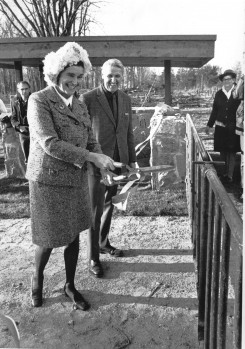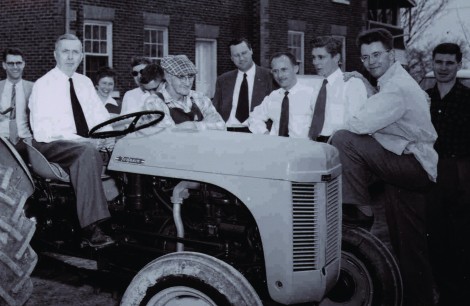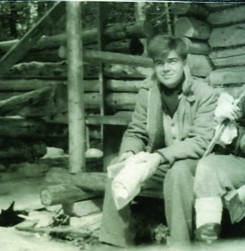The sun blazes overhead on a hot June afternoon as one young student coats his skin with sunscreen to prepare for the hours ahead. A mass of weeds have invaded the farm plots with a vengeance — and they must go.
It’s Midsummer’s Eve, an overnight event celebrating the summer solstice. It’s also the Hart House Farm Committee’s first attempt at student-led farming.
Under the guidance of committee volunteers, students get their first experience in the field as they till the soil, weed, and pile potatoes, and plant the farm’s first crop of corn. A feast is held to honour the start of summer and the people who made this day happen. Soon after, a group gathers by a bonfire in the field. It’s a full moon and anything feels possible. This is the experience the farm committee hopes to give students in the future.
For those who use the farm as it was intended (as a rustic retreat and meeting place), it may come as a surprise to learn what a group of students have been trying to do here for the last three years. The student members of the farm committee are transforming the farm into a student centre of food, farming, co-curricular education, and a hub for the environmentally conscious and plain old outdoorsy. After 63 years, they’re finally bringing the “farm” back to the Hart House Farm.
The 150-acre Hart House Farm was purchased in 1949 under the leadership of late warden Nicholas Ignatieff (yes, he’s related to the former Liberal Party leader). It was envisioned as a country recreation centre where urban U of T students could escape the drudgery of the city and experience nature. U of T’s original Outing Club was formed to manage the farm, which later merged with the Hart House Exploration Society to become the Hart House Farm Committee. Since its purchase, the farm has been a hub for student engagement and activity. It was also one of the first places at Hart House that allowed equal access for women and men.
[pullquote]The student members of the farm committee are transforming the farm into a student centre of food, farming, co-curricular education, and a hub for the environmentally conscious and plain old outdoorsy.[/pullquote]
It’s a property steeped in mystery and tradition. Farm legend has it that William Lyon Mackenzie, the first mayor of Toronto, hid in the crevices of the escarpment after the failed Upper Canada rebellion against
colonial British rule before hightailing it to Buffalo in 1837. Quarries were located at the current sites of the three ponds, and the ruins of old quarry buildings can still be seen hidden in the woods and submerged in water. Pink dolomite was quarried from 1882 to 1916 and it’s speculated that this stone may have been used in the construction of Victoria College and Hart House. The farm work clause in the booking contract has stipulated for decades that in exchange for reasonable fares, guests are expected to work for two hours under the farm resident. This was once frequently enforced, and students in fact helped to reforest the farm, rebuild the burned-down sauna, and complete Bryce Hall.
* * *
In an historic room exuding an air of formality and tradition in Hart House, two long varnished tables are worn down from years of heated discussions. Here sits a democratic committee of students, faculty, and staff who administer the farm facilities and plan for its future.
This is where determined students have been fighting to make farming a reality at Hart House. To the committee, it’s an easy choice. The farm is a response to the accelerated loss of farmland and green space around the GTA due to sprawl and the lack of awareness of food and environmental issues on campus.
Despite time constraints and a lack of funding, expertise, volunteers, and support, the farm sustainably produced 205 lbs of apples, 5 kg of greens, and enough corn, onions, and potatoes to feed 40 people. These were harvested and eaten at the committee’s first harvest festival, sold at their farmer’s market, or purchased by the Hot Yam!, a student-run kitchen.
This success has energized the committee, and they’re currently working on expanding the amount and diversity of food grown on the farm, adding more exciting programming to their line-up and hoping to involve more students in the process — all this while maintaining student direction. After all, other universities like UBC and Guelph have active farms, so why can’t we?
The thing about running a farm is that people want to talk to you. Students are always enthusiastic and eager to contribute. They want to get outside and learn more about food after being disconnected from its
production for so long (no, Farmville doesn’t count), but that enthusiasm usually seems to disappear after a paper or a looming midterm.
Like any other student organization, it’s a constant struggle to keep students engaged. That makes long-term planning difficult because of the dependence on a few dedicated individuals and attrition after graduation. Three years ago, the farm committee was struggling to define what it stood for, and it lacked direction. They are following their new vision, but it’s clear that the farm needs increased awareness, student participation, and collaboration with faculty and other student groups to achieve its goals.
Many projects have started to transform the farm and the committee into a dynamic place of student learning, outdoor activities, and environmentalism. Starting next year, the Green Idea Fund — inspired by Hart House’s Good Idea Fund — will be set up to provide funding for students interested in running student activities or addressing contemporary environmental and social issues.
This year, the committee is collaborating with the Hot Yam!, Campus Agriculture, and the KEG, a farming co-op, to provide food-related programming; Bikechain has gotten involved by giving introductory bike tours. The committee is restoring a greenhouse with Greenhouse Renewal Group in the anthropology building to prepare seedlings for the spring and to educate students about indoor gardening. There are even talks about developing the research potential of the farm with faculty. And of course, there’s a focus on student-directed farming. Perhaps there will be new egg-laying residents by the fall (that’s chickens, for you city kids), but there is still a long way to go.
It’s rare for students to have the ability to partake in large projects like this and be rewarded for their effort and determination. That’s the beauty of Hart House Farm.
To learn more about what the farm committee has got planned this year, check out their website at
www.harthouse.ca/farmcommittee to get involved.







